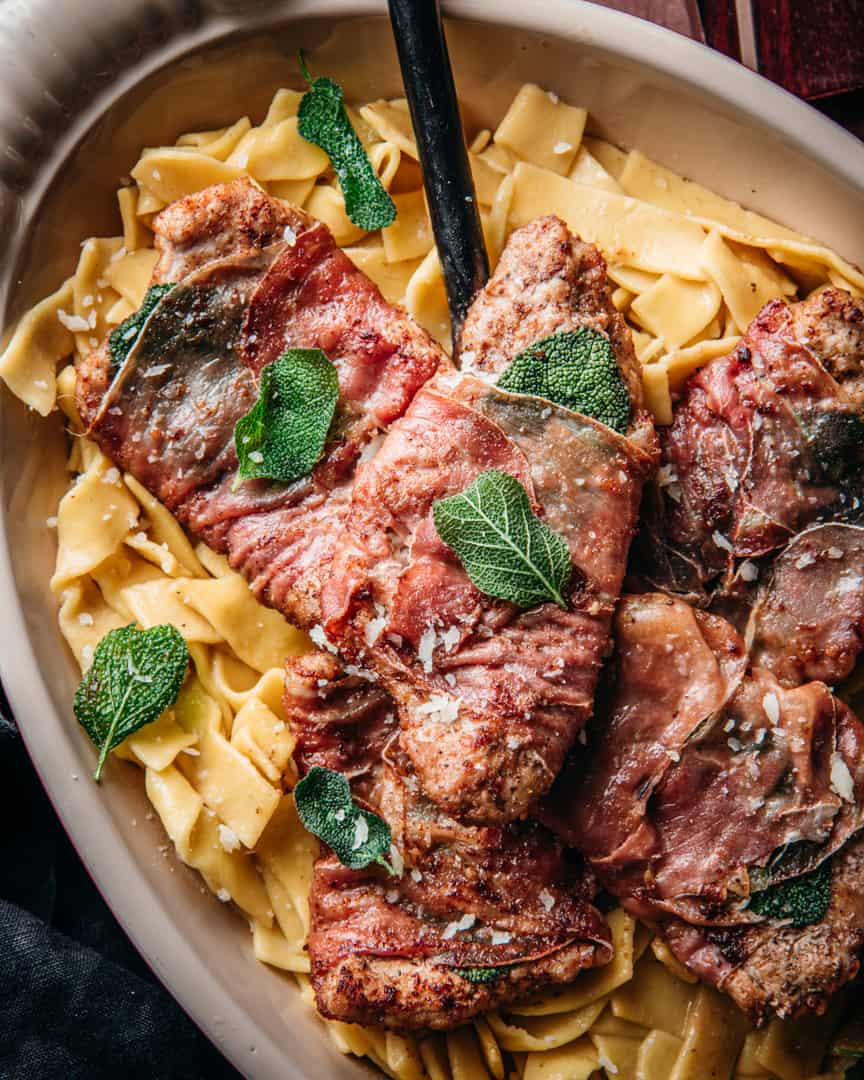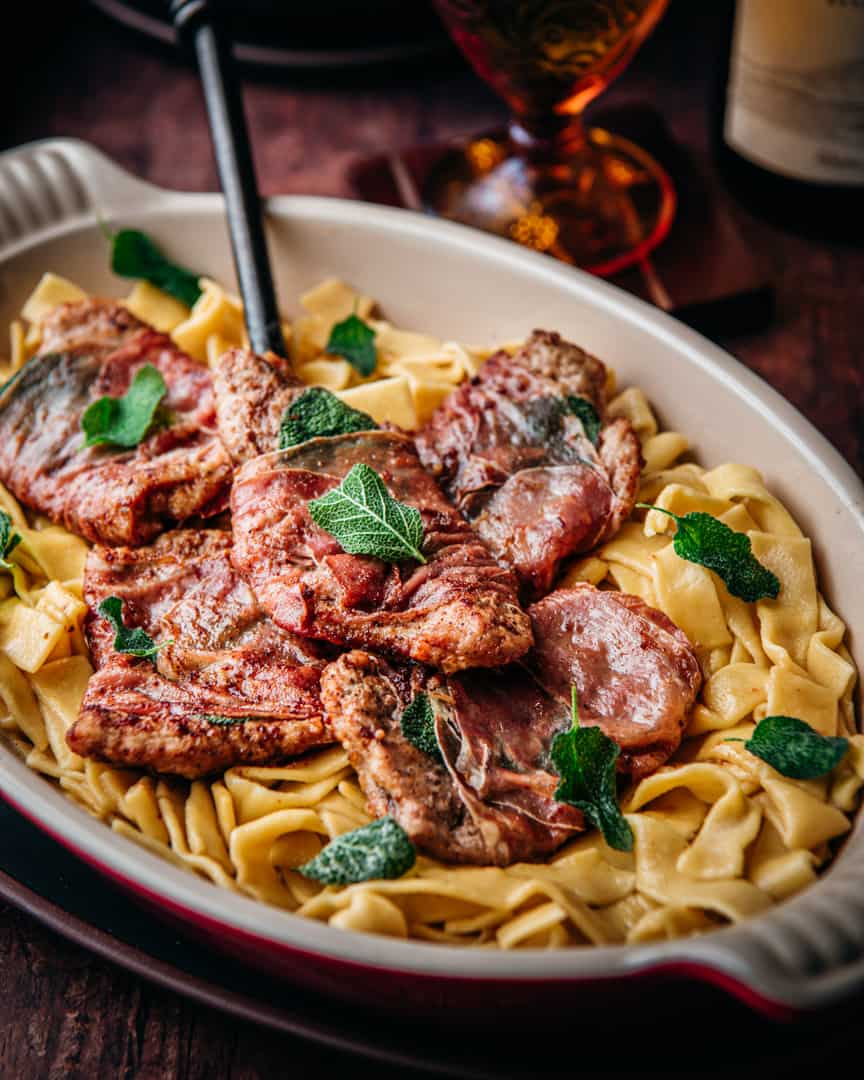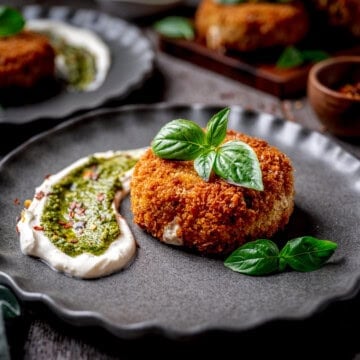Saltimbocca alla Romana is a delicious classic Italian dish consisting of thin cuts of veal (or chicken or pork if you prefer) wrapped in prosciutto with sage leaves. The dish is typically cooked with dry white wine and butter to make a delicious pan sauce and enjoyed with pasta! This is one of our favorite Italian dishes, and it is surprisingly very simple to make.

Jump to:
- What even is Saltimbocca?
- Is Saltimbocca made with Veal, Chicken or Pork?
- Ingredients
- Substitutions
- How to Make Saltimbocca alla Romana?
- Equipment
- Step-by-Step Instructions
- Variations
- Storage
- Top tip
- Troubleshooting
- What to Serve with Veal Saltimbocca?
- What wines to pair with Saltimbocca?
- Looking for more Italian recipes?
- FAQ
- 📖 Recipe
What even is Saltimbocca?
A little about the dish: The literal translation of Saltimbocca means “to jump in mouth” in Italian and for a good reason. This is a flavor bomb!
Saltimbocca is considered a Roman dish – where it actually originated is somewhat disputed - but this is where the "alla Romana" comes in, meaning "Roman style." Wherever in Italy this actually originated is for a food history blog, which you won't find a ton of here! But veal cutlets cooked in butter and white wine, with prosciutto and sage just screams “jump in my mouth!”
Is Saltimbocca made with Veal, Chicken or Pork?
Traditionally this Roman classic dish is made with veal scaloppini, or thin slices of veal. Although nothing rivals veal here (opinion alert) you can use thin pieces of pork or chicken if you have some problems finding veal or other personal problems with eating it. However, veal is amazing in this and you’ll be wanting it again and again.
We are progressive cooks, so tradition is an aspect of our cooking but not the be-all-end-all. We have tried variations – many – and this is our favorite for its simplicity and taste and, by many standards, quite traditional.
Ingredients
Like many classic Roman dishes, Veal Saltimbocca is quite straightforward and simple to make with just a few ingredients. Here is what you need:
- Veal scallopini: about the size of your hand and pounded to ¼ inch thick (alternatively use 2 chicken breasts cut in half horizontally or pork cutlets)
- Prosciutto: Any Italian variety will work, our favorite is Prosciutto San Daniele, but Prosciutto di Parma is a classic.
- Fresh Sage leaves: Large sage leaves are a signature of this dish
- Kosher Salt
- Black Pepper
- Flour: All purpose flour is fine to use here.
- Unsalted Butter: We always use unsalted butter so we can control the salt content and use salt we prefer.
- Olive Oil: We use inexpensive extra virgin olive oil
- Dry White Wine: An inexpensive but good Pinot Grigio is perfect for this dish.
See recipe card below for quantities.
Substitutions
Here are a few common substitutions for the ingredients in this recipe:
- Veal: As mentioned, you can substitute the veal in this recipe for chicken breast or pork.
- Flour: You may be wondering, 'Can I omit the flour in this recipe?' We have tried making saltimbocca with and without dredging in flour, and it is tasty either way. We prefer flouring the veal to develop a bit of texture to the meat and thickness to the sauce, but if you are on a gluten free diet or want to avoid the extra carbs, it doesn't change the taste to omit the flour from this dish.
How to Make Saltimbocca alla Romana?
This dish is quite simple to prepare and cook without any special equipment or skills. Let's go over what is needed.
Equipment
- Stainless steel large sauté pan or frying pan
- Wooden spoon (flat ended is best)
Step-by-Step Instructions
Step 1: Saltimbocca Assembly
- We cook a “flat” version of saltimbocca typically. The flat version of veal saltimbocca has a slice of prosciutto and sage fixed to the slice of veal by either wrapping the prosciutto around the meat or holding it in place with a toothpick. You will want to place the sage leaves inside the prosciutto unless you want the sage to cook to a crisp (believe us, you do not want this). Cooking the sage between the meat and prosciutto layer will allow it to maintain its flavor and allow the prosciutto to crisp up a bit instead. Lightly salt and pepper the veal slices, then put one large sage leaf on the veal. Wrap across the short side with one piece of prosciutto. Dredge both sides lightly in flour.
Step 2: Cook the veal
- Melt 2 tablespoons of butter with olive oil over medium-high heat in a stainless steel pan or large skillet. Once melted, reduce heat to medium-low and add the veal to the pan and cook the veal for about 1.5 minutes per side. Since the veal is very thin, this should cook the veal through to the desired doneness with a nice golden brown crust on the outside. Remove to a plate, cover with foil and set aside (or cover lightly with foil and place on an oven safe tray in a warm oven until ready to serve).
Step 3: Deglaze
- Add the white wine to the pan over medium-high heat and deglaze the pan with a wooden spoon, scraping the brown bits (frond) from the bottom of the pan. Reduce the heat to medium and cook the wine until it is reduced by half.
Step 4: Finish the sauce
- Remove the pan from the heat and whisk in the remaining butter, one tablespoon at a time. Serve the sauce over the veal and enjoy!

Variations
Here are some tasty variations on this recipe:
- Roll it up! Saltimbocca can be rolled as well, which is a little trickier to cook, takes a bit longer, but has a different flavor that you may prefer (or may not) so it’s worth a try.
- As mentioned before, you can make this recipe with pork or chicken.
Storage
How to store leftovers in the fridge:
It’s hard to believe there will be leftovers, but if there are, just store them in a tightly sealed container in the fridge for up to 4-5 days.
Can you freeze Saltimbocca?
We wouldn’t recommend freezing this dish as it is quite easy to make from scratch. This is especially true if the veal (or other protein you used) was frozen before you made the dish - you shouldn't refreeze meat that has previously been frozen.
How to reheat?
Reheat slowly in a skillet on low to medium low heat until heated through.
Top tip
If the veal cutlets you are using are too large to wrap the prosciutto around, you can use a wooden toothpick or two to affix the prosciutto to the veal. Just remember to remove before serving!
Troubleshooting
Overcooked veal? Veal scallopini cooks very quickly and so does prosciutto. You don’t need to have the heat super high as you are just trying to cook through a ¼” piece of veal.
What to Serve with Veal Saltimbocca?
Saltimbocca can be served with many things, but we like a little pasta to go with it and something light and green. Beans, peas, asparagus, wilted spinach or other greens, etc. all work in our opinion. We recommend making this with our homemade pasta.
Another option is to serve it over polenta! To stick with the flavor theme of this dish, try it with our Brown Butter and Sage Polenta.
This is an easy but decadent dish that will impress at a dinner party or just a great dish for one or two at home anytime. Quality veal and good prosciutto and you have an almost foolproof dish!
What wines to pair with Saltimbocca?
Of course a good wine is always necessary to pair with veal saltimbocca – Pinot Noir or a Chianti for reds or a Pinot Grigio for whites – will make this perfection.
Looking for more Italian recipes?
If you love Italian food as much as we do and want more Italian recipes, you can find the classics under Classic Italian Recipes.
We also have a cookbook, Mangiamo. It includes 60 incredibly delicious Italian and Italian-inspired recipes.

FAQ
It means “to jump in mouth” in Italian. This is due to the tremendous amount of flavor in this dish.
We prefer to deglaze with a white wine with some acidity such as Pinot Grigio. Any dry, crisp white wine will work well in this recipe.
Italians, like many Europeans, love veal. There are many dishes that are very popular using scallopini like the ones in this recipe. They include veal marsala, veal piccata, veal parmigiana, and others. Veal shanks are used to make the famous braised dish from Lombardy Osso Buco. Veal alla Milanese is a breaded veal chop cooked gently in butter and is also from Lombardy, specifically Milan.
📖 Recipe

Saltimbocca alla Romana
Ingredients
- 4 pieces of veal scallopini - about the size of your hand and pounded to ¼ inch thick (alternatively use 2 chicken breasts cut in half horizontally or pork cutlets)
- 4 pieces of thinly sliced prosciutto
- 4 Sage leaves
- 1 teaspoon kosher salt
- 1 teaspoon black pepper
- ½ cup flour
- 6 tablespoon unsalted butter (divided)
- 1 teaspoon olive oil
- ½ cup white wine (pinot grigio)
Instructions
PREPARATION
- Lightly salt and pepper both sides of the veal
- Place one sage leaf on each piece of veal, then wrap one piece of prosciutto around the veal. If your veal pieces are too large and the prosciutto won't wrap around completely, you can affix the prosciutto to the veal with toothpicks (remove toothpicks before serving).
- Dredge both sides of the veal lightly in the flour and set aside.
- Melt 2 tablespoon butter with olive oil over medium-high heat in a stainless steel pan. Once melted, reduce heat to medium-low and add the veal to the pan and cook veal for about 1.5 minutes per side. Since the veal is thin, this should cook the veal through to the desired doneness. Remove to a plate, cover with foil and set aside (or cover and place in on an oven safe tray in a warm oven until ready to serve).
- Next, add wine to the pan and deglaze with a wooden spoon. Reduce the wine by about half or until slightly thick and silky.
- Remove the pan from the heat and whisk in the last 4 tablespoon of butter, 1 tablespoon at a time. Once the butter is incorporated, serve the veal with sauce over the top. If making this dish with pasta, toss the cooked pasta in the pan with the sauce before serving.





Leave a Reply